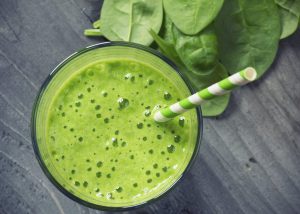“Are green smoothies bad for You?” This is a very interesting question
Unhealthy lifestyles that are characterized by lack of exercise, cigarette smoking, excessive alcohol consumption and lack of essential nutrients due to low consumption of nutrient dense fruits and vegetables are all associated with an increase in all-cause mortality. (Source)

So how best can we infuse ourselves with the nutrients found in fruits and vegetables? Well the best way to do that is by blending these wholes foods into smoothies.
Fruit and vegetables are the most nutrient-dense foods on the planet, and dark green leafy vegetables lead the pack.
Each of the top five so-called “powerhouse fruits and vegetables” were greens. And so if we blend them up in a smoothie (or soup or sauce), we’re taking the food with the most nutrition and breaking all the cells to dump that nutrition into our bloodstream.
Chewing is good, but blending is better in terms of digestive efficiency and absorbing nutrients. This is especially so if a person is very sick and has low energy to digest solid foods.
But if we suck up all that nutrition such that none makes it down to our colon, might we be starving our microbial selves? The reason intact grains, beans, and nuts are better than bread, hummus, and nut butters is that no matter how well we chew, intact food particles make it down to your colon, where they can offer a smorgasbord for your good bacteria.
But if your grains, beans, and nuts are finely ground up into flour or paste before you eat it, you may be leaving your gut flora high and dry. Would the same concern be true for fruits and vegetables?
There are special classes of phytonutrients in fruits and vegetables that appear to protect against colon cancer. They can escape digestion and absorption in our stomach and small intestine and end up in our colon to act as prebiotics.
No matter how much we chew them stay attached to the fiber. But if we use a blender, might we prematurely detach these nutrients? No. Even if you blend in a high speed blender for 5 minutes, they remain bound to the fiber for transport down to your colon bacteria.
You can do smoothie experiments on people with ileostomy bags that drain the contents of the small intestine and show that most of the polyphenol phytonutrients make it out intact, so we don’t have to worry we may be robbing Peter to pay Paul when we blend fruits and vegetables.
So, is there any downside to smoothies, then?
Well, just as smaller particle size may improve digestive efficiency and gastrointestinal absorption of nutrients from fruits and vegetables, the same may be true for grains, but the concern is that this could boost starch availability and cause a blood sugar spike. For example, here’s the rise and fall in our blood sugar in the four hours after eating a half a cup of brown rice, eliciting a nice gentle bump in our insulin levels to take care of it.
Doesn’t even go above normal fasting blood sugar levels. But what if we ate the same amount of brown rice, but first ground into brown rice flour, so like a cream of brown rice hot cereal.
You get twice the blood sugar, twice the insulin spike. Same amount of food, just in a different form. Another reason why intact whole grains are better than just whole grain flour products.
Even just chewing really well can boost the glycemic and insulin response. Here’s if you just chew rice regularly and here’s if you chew really well. The smaller rice particles empty out of your stomach faster producing greater blood sugar and insulin responses.
It’s ironic that there were health crusaders pushing people to chew more to digest their food better, but if what you’re chewing is a five cheese pizza, maybe it’s better not to digest so well. Some have even suggested that diabetics and obese persons not chew their food so much. Swallowing diced food without chewing would not only reduce the pleasure of eating, though, but people could choke on it.
Still, though, they suggest it could be a simple way to allow patients to reduce their blood sugar levels without fundamentally altering their diets and may thus prove more acceptable than having to do the unthinkable— eat high fiber foods like beans, which have been shown to blunt blood sugar spikes. Even blended beans like hummus?
Yes, unlike grains, blending legumes does not affect their glycemic response. So, circling back to the smoothie question, is fruit more like grains or more like beans? If you liquefy fruit in a blender to make a smoothie, do you risk spiking your blood sugar too high?
Here is an excellent smoothie recipe taken from loseweightbyeating.com/
This is another fantastic recipe that is full of antioxidants and vitamins. It has a slightly sweet flavor, with a little tanginess from the pineapple and orange.
Carrots have a number of health benefits. They are a good source of beta-carotene, fiber, vitamin K, potassium, antioxidants and have been linked to lower cholesterol levels and improved eye health (13).
Green Tropical Sunrise Ingredients:
-
¼ cup pineapple
-
1 orange peeled
-
1 carrot
-
1 cup spinach
-
1 tablespoon flax seeds
-
1 cup water
My conclusion, is that taking in green smoothies or any other smoothies is good for you and it should form part of your diet, especially in periods of fasting or when you have health challenges that makes you weak and lacking in energy.
